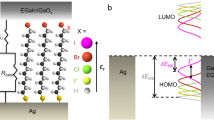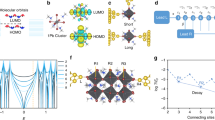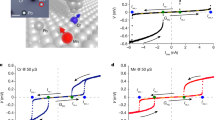Abstract
Fabrication of structures at the atomic scale is now possible using state-of-the-art techniques for manipulating individual atoms1, and it may become possible to design electrical circuits atom by atom. A prerequisite for successful design is a knowledge of the relationship between the macroscopic electrical characteristics of such circuits and the quantum properties of the individual atoms used as building blocks. As a first step, we show here that the chemical valence determines the conduction properties of the simplest imaginable circuit—a one-atom contact between two metallic banks. The extended quantum states that carry the current from one bank to the other necessarily proceed through the valence orbitals of the constriction atom. It thus seems reasonable to conjecture that the number of current-carrying modes (or ‘channels’) of a one-atom contact is determined by the number of available valence orbitals, and so should strongly differ for metallic elements in different series of the periodic table. We have tested this conjecture using scanning tunnelling microscopy and mechanically controllable break-junction techniques2,3 to obtain atomic-size constrictions for four different metallic elements (Pb, Al, Nb and Au), covering a broad range of valences and orbital structures. Our results demonstrate unambiguously a direct link between valence orbitals and the number of conduction channels in one-atom contacts.
This is a preview of subscription content, access via your institution
Access options
Subscribe to this journal
Receive 51 print issues and online access
$199.00 per year
only $3.90 per issue
Buy this article
- Purchase on Springer Link
- Instant access to full article PDF
Prices may be subject to local taxes which are calculated during checkout



Similar content being viewed by others
References
Crommie, M. F., Lutz, C. P. & Eigler, D. M. Confinement of electrons to quantum corrals on a metal surface. Science 262, 218– 220 (1993).
van Ruitenbeek, J. M. in Mesoscopic Electron Transport (eds Sohn, L. L., Kouwenhoven, L. P. & Schön, G.) 549–579 (Kluwer Academic, Dordrecht, (1997)).
van Ruitenbeek, J. M. et al. Adjustable nanofabricated atomic size contacts. Rev. Sci. Instrum. 67, 108–111 (1996).
Landauer, R. Electrical resistance of disordered one-dimensional lattices. Phil. Mag. 21, 863–867 ( 1970).
Scheer, E., Joyez, P., Esteve, D., Urbina, C. & Devoret, M. H. Conduction channel transmissions of atomic-size aluminum contacts. Phys. Rev. Lett. 78, 3535– 3538 (1997).
Octavio, M., Tinkham, M., Blonder, G. E. & Klapwijk, T. M. Subharmonic energy-gap structure in superconducting constrictions. Phys. Rev. B 27, 6739–6746 (1983).
Averin, D. & Bardas, A. AC Josephson effect in a single quantum channel. Phys. Rev. Lett. 75, 1831– 1834 (1995).
Cuevas, J. C., Martín-Rodero, A. & Levy Yeyati, A. Hamiltonian approach to the transport properties of superconducting quantum point contacts. Phys. Rev. B 54, 7366–7379 (1996).
Bratus, E. N., Shumeiko, V. S., Bezuglyi, E. V. & Wendin, G. dc-current transport and ac Josephson effect in quantum junctions at low voltage. Phys. Rev. B 55, 12666– 12677 (1997).
Agraït, N., Rodrigo, J. G. & Vieira, S. Conductance steps and quantization in atomic-size contacts. Phys. Rev. B 47, 12345– 12348 (1996).
Rubio, G., Agraït, N. & Vieira, S. Atomic-sized metallic contacts: mechanical properties and electronic transport. Phys. Rev. Lett. 76, 2302–2305 (1996).
Krans, J. M., van Ruitenbeek, J. M., Fisun, V. V., Yanson, I. K. & de Jongh, L. J. The signature of conductance quantization in metallic point contacts. Nature 375 , 767–769 (1995).
Landman, U., Luedtke, W. D., Salisbury, B. E. & Whetten, R. L. Reversible manipulations of room temperature mechanical and quantum transport properties in nanowire junctions. Phys. Rev. Lett. 77, 1362–1365 (1996).
Todorov, T. N. & Sutton, A. P. Jumps in electronic conductance due to mechanical instabilities. Phys. Rev. Lett. 70, 2138–2141 (1993).
Beenakker, C. W. J. Quantum transport in semiconductor superconductor microjunctions. Phys. Rev. B 46, 12841–12844 (1992).
Cuevas, J. C., Levy Yeyati, A. & Martín-Rodero, A. Microscopic origin of the conducting channels in metallic atomic-size contacts. Phys. Rev. Lett. 80, 1066–1069 (1998).
Levy Yeyati, A., Martín-Rodero, A. & Flores, F. Conductance quantization and electron resonances in sharp tips and atomic size contacts. Phys. Rev. B 56, 10369–10372 (1997).
Lang, N. D. Resistance of atomic wires. Phys. Rev. B 52, 5335–5342 (1995).
Wan, C. C., Mozos, J.-L., Taraschi, G., Wang, J. & Guo, H. Quantum transport through atomic wires. Appl. Phys. Lett. 71, 419– 421 (1997).
Brandbyge, M., Sørensen, M. R. & Jacobsen, K. W. Conductance eigenchannels in nanocontacts. Phys. Rev. B 56, 14956– 14959 (1997).
Belzig, W., Bruder, C. & Schön, G. Local density of states in a dirty normal metal connected to a superconductor. Phys. Rev. B 54, 9443 –9448 (1996).
Acknowledgements
We thank D. Esteve and M. H. Devoret for discussions and C. Sürgers for graphics preparation; N.A. and G.R.B. thank S. Vieira for discussions and support. The work was supported in part by the Deutsche Forschungsgemeinschaft (DFG), the Spanish CICYT, “Stichting FOM” (NWO) and the Bureau National de Métrologie (BNM).
Author information
Authors and Affiliations
Corresponding author
Rights and permissions
About this article
Cite this article
Scheer, E., Agraït, N., Cuevas, J. et al. The signature of chemical valence in the electrical conduction through a single-atom contact. Nature 394, 154–157 (1998). https://doi.org/10.1038/28112
Received:
Accepted:
Published:
Issue Date:
DOI: https://doi.org/10.1038/28112
This article is cited by
-
Observation of single-defect memristor in an MoS2 atomic sheet
Nature Nanotechnology (2021)
-
Single channel Josephson effect in a high transmission atomic contact
Communications Physics (2020)
-
A novel shaped-controlled fabrication of nanopore and its applications in quantum electronics
Scientific Reports (2019)
-
Controlling the thermoelectric effect by mechanical manipulation of the electron’s quantum phase in atomic junctions
Scientific Reports (2017)
-
Transformation from slip to plastic flow deformation mechanism during tensile deformation of zirconium nanocontacts
Scientific Reports (2017)
Comments
By submitting a comment you agree to abide by our Terms and Community Guidelines. If you find something abusive or that does not comply with our terms or guidelines please flag it as inappropriate.



